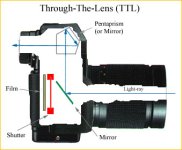Horoscope Fish
Senior Member
Live View does move the mirror up and out of the way so the image coming through the lens can be projected straight on to the cameras sensor. That same image is then output from the sensor to the rear-LCD and we can use the LCD for framing and focusing instead of the viewfinder. Some people simply prefer this method and Live View does use a different method for achieving focus (Google "Phase Detection" vs "Contrast Detection" if you really want to get your geek-on) which some people also prefer.Ahhh! So live view isn't designed for everyday hand held use? I never use it so I wasn't sure. I though it was just another way to use the camera for people who didn't like using the viewfinder or when using the camera for motion video. I toyed with it a few minutes ago and I definitely don't like it. Might try it for some tripod macro shots one day.
However, my D90 has a mirror lock up option that does not require Live View.
When I say "Mirror Lock-up", though, I'm referring to an option I specifically employ for stills in order to prevent "mirror slap" and increase sharpness.
The same action is being taken in both cases -- the mirror is moved out of the way of the sensor -- but it's being done for two different reasons.
Clear as mud?
....
Last edited:

